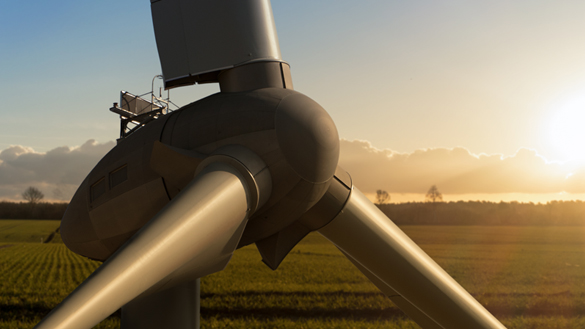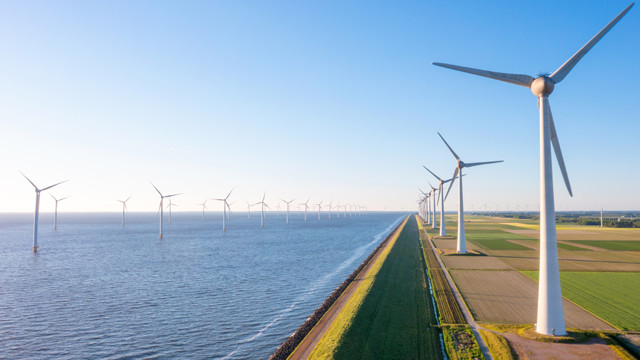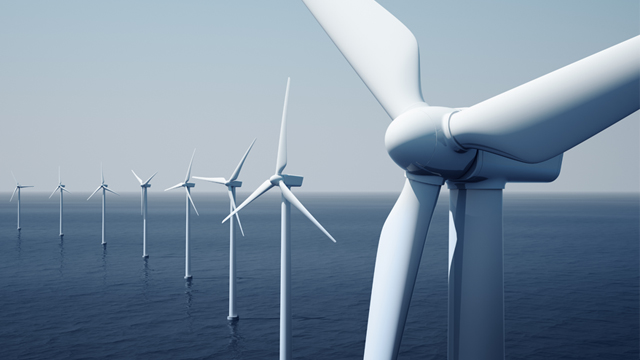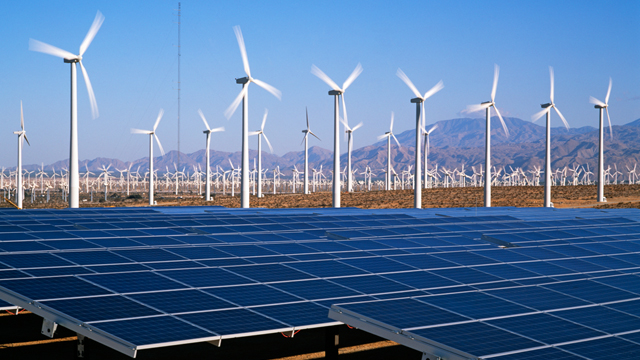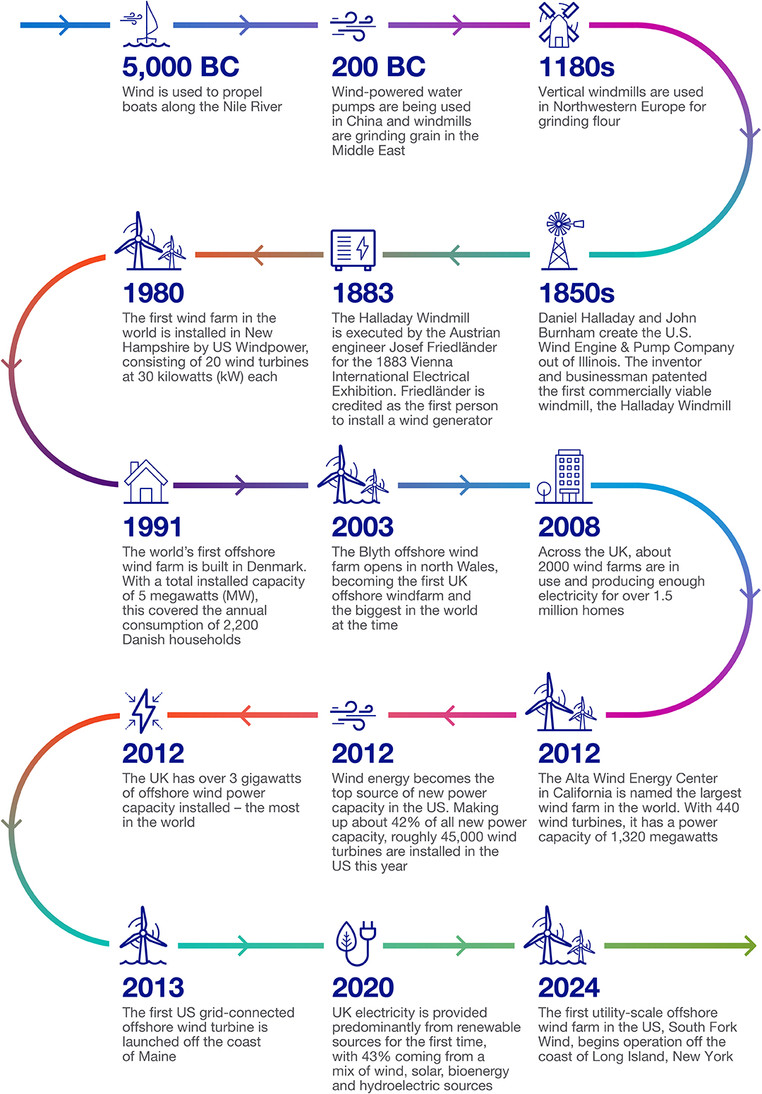
The history of wind energy
Wind is a growing source of reliable and clean energy around the world and a crucial part of the journey to net zero. But when did people first start to harness the power of the wind? When was the first wind turbine created? What did wind energy look like and how has it evolved?
Here we look at the history of wind energy, significant discoveries made along the way, where we are now and what the future of wind power looks like.

When was the first instance of wind energy?
Ingrained in our world history, people have been using wind energy for thousands of years. As early as 5,000 BC, wind was used to propel boats along the river Nile. In 200 BC, wind-powered water pumps were being integrated in China and windmills were grinding grain in the Middle East. By the 11th century, the Middle East were using wind pumps and mills for food production. American colonists used wind power extensively for grinding grain, pumping water and cutting wood. As they settled in the United States, homesteaders and ranchers installed thousands of wind pumps.1
How is wind energy generated now?
Wind turbines – the modern version of a windmill – use the power of the wind to create electricity. Large commercial wind turbines are the most visible, but you can also buy a small wind turbine for individual use; for example to provide power to a caravan or boat.
Wind turbines consist of a set of blades, a box beside them called a nacelle and a shaft. The wind – even just a gentle breeze – makes the blades spin, creating kinetic energy. The blades rotating in this way then also make the shaft in the nacelle turn and a generator in the nacelle converts this kinetic energy into electrical energy.
Find out more about how wind turbines work
When was the first commercial wind turbine created?
In the 1850s, inventor Daniel Halladay and businessman John Burnham created the U.S. Wind Engine & Pump Company out of Illinois. They patented the first commercially viable windmill, the Halladay Windmill.2 The Halladay Windmill was then implemented by the Austrian engineer Josef Friedländer for the 1883 Vienna International Electrical Exhibition. With a 22 foot (6.6 metres) diameter, Friedländer is credited as the first person to install a wind generator.3
In the UK, the first windmill for electricity was built in 1887 by James Blyth in Glasgow, Scotland.4 The first wind turbine in the United States was installed by American industrialist Charles Brush in 1888. Based in Cleveland, Ohio, the 56 foot (17 metre) diameter windmill was used to light Brush’s estate.5
How did the first wind turbine operate?
The Halladay windmill was innovative and revolutionary. This self-sufficient windmill automatically turned to face changing wind directions, in addition to maintaining an even speed by changing the pitch of the sails. As stated in the New-York Tribune in 1854, “The wind wheel is ten feet and it has been in operation for six months without a hand being touched to it to regulate the sails.” The windmill successfully drew water from a well 28 feet deep, a useful tool for farming and garden irrigation.2
The Halladay windmill had a secure vane and four compact blades mounted on the main shaft. To produce the greatest amount of power, the vane kept the wheel of the blades facing the wind at a specific angle.6
How has wind power evolved?
An important moment in history for wind power was during the US energy crisis of the 1970s, which forced researchers and leaders to explore alternative energy options.7 Development came primarily from the US with a research program backed by NASA, designed to find a utility scale energy resource. In 1978, congress passed the Public Utility Regulatory Policies Act, requiring companies to buy a fixed amount of electricity from renewable energy sources.8 By the 1980s, governments began promoting clean energy sources with the State of California by offering tax rebates.9
The first wind farm in the world was installed in December 1980 in New Hampshire by U.S. Windpower, consisting of 20 wind turbines at 30 kilowatts (kW) each.10 In November 1991, the Delabole wind farm was created consisting of 10 turbines, the first commercial wind farm in the UK.4
The world’s first offshore wind farm, Vindeby, was built in 1991 in Denmark with 11 450kW turbines. With a total installed capacity of 5 megawatts (MW), this covered the annual consumption of 2,200 Danish households. It has since been decommissioned in 2017.11
The Blyth offshore wind farm – beginning operation in 2003 – became the first UK offshore windfarm and the biggest in the world at the time.12
In 2011, the U.S. Department of Energy released the National Offshore Wind Strategy, introducing an innovative way to generate wind energy. The University of Maine then deployed a 20kW concrete-composite floating wind turbine in 2013 – this became the first US grid-connected offshore wind turbine.13
What does the future of wind energy look like?
The U.S. Department of Energy’s (DOE) Wind Energy Technologies Office have conceptualised a new vision of wind energy through 2050, revisiting the department’s 2008 report. They hypothesise that wind energy will be a practicable source of electricity in all 50 states and that wind energy can avoid 12.3 gigatonnes of greenhouse gases – the equivalent of taking about 1.3 million cars off the road14 – by 2050. Wind energy has the potential to support over 600,000 green jobs in the US, including installation, maintenance and manufacturing.15
In 2024, China’s installed wind and solar capacity is predicted to surpass coal for the first time. Similarly, the largest wind turbines in the world are being built in China, each turbine at 131 metres (about 430 feet) long.
The UK government aims to deliver 50 gigawatts (GW) of offshore wind by 2030. As this offshore wind generation increases, the infrastructure to deliver the energy from wind farms at sea to consumers across Great Britain needs to be reinforced, known as The Great Grid Upgrade.
Last updated: 24 Apr 2024
The information in this article is intended as a factual explainer and does not necessarily reflect National Grid's strategic direction or current business activities.
Listen to our podcast episode:
Sources:
1 History of wind power - U.S. Energy Information Administration (EIA)
4 Timeline: The history of wind power | Wind power | The Guardian
5 Austrian was First with Wind-Electric Turbine Not Byth or de Goyon – WIND WORKS (wind-works.org)
6 The Halladay and Jacobs Windmills - Electricity & Alternative Energy - Alberta's Energy Heritage
7 The evolution of wind turbines - Action Renewables
8 History of U.S. Wind Energy | Department of Energy
9 The history of Wind Turbines (renewableenergyhub.co.uk)
10 Wind Energy Center Alumni | Wind Energy Center (umass.edu)
11 Vindeby Offshore Wind Farm | Tethys (pnnl.gov)
12 Oyster | A Brief History of UK Wind Energy. (oysterpartnership.com)
14 Scout Clean Energy - Scouting Frontiers In Renewable Energy
15 Wind Vision | Department of Energy
